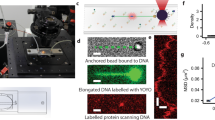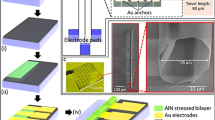Abstract
Investigating biological and synthetic nanoscopic species in liquids, at the ultimate resolution of single entity, is important in diverse fields1,2,3,4,5. Progress has been made6,7,8,9,10, but significant barriers need to be overcome such as the need for intense fields, the lack of versatility in operating conditions and the limited functionality in solutions of high ionic strength for biological applications. Here, we demonstrate switchable electrokinetic nanovalving able to confine and guide single nano-objects, including macromolecules, with sizes down to around 10 nanometres, in a lab-on-chip environment. The nanovalves are based on spatiotemporal tailoring of the potential energy landscape of nano-objects using an electric field, modulated collaboratively by wall nanotopography and by embedded electrodes in a nanochannel system. We combine nanovalves to isolate single entities from an ensemble, and demonstrate their guiding, confining, releasing and sorting. We show on-demand motion control of single immunoglobulin G molecules, quantum dots, adenoviruses, lipid vesicles, dielectric and metallic particles, suspended in electrolytes with a broad range of ionic strengths, up to biological levels. Such systems can enable nanofluidic, large-scale integration and individual handling of multiple entities in applications ranging from single species characterization and screening to in situ chemical or biochemical synthesis in continuous on-chip processes.
This is a preview of subscription content, access via your institution
Access options
Access Nature and 54 other Nature Portfolio journals
Get Nature+, our best-value online-access subscription
$29.99 / 30 days
cancel any time
Subscribe to this journal
Receive 12 print issues and online access
$259.00 per year
only $21.58 per issue
Buy this article
- Purchase on Springer Link
- Instant access to full article PDF
Prices may be subject to local taxes which are calculated during checkout




Similar content being viewed by others
References
Greber, U. F. & Way, M. A superhighway to virus infection. Cell 124, 741–754 (2006).
Pang, Y., Song, H., Kim, J. H., Hou, X. & Cheng, W. Optical trapping of individual human immunodeficiency viruses in culture fluid reveals heterogeneity with single-molecule resolution. Nat. Nanotech. 9, 624–630 (2014).
Amstad, E. & Reimhult, E. Nanoparticle actuated hollow drug delivery vehicles. Nanomedicine 7, 145–164 (2012).
Aguilar, C. A. & Craighead, H. G. Micro- and nanoscale devices for the investigation of epigenetics and chromatin dynamics. Nat. Nanotech. 8, 709–18 (2013).
Neuman, K. C. & Nagy, A. Single-molecule force spectroscopy: optical tweezers, magnetic tweezers and atomic force microscopy. Nat. Methods 5, 491–505 (2008).
Grier, D. G. A revolution in optical manipulation. Nature 424, 810–816 (2003).
Berthelot, J. et al. Three-dimensional manipulation with scanning near-field optical nanotweezers. Nat. Nanotech. 9, 295–299 (2014).
Fields, A. P. & Cohen, A. E. Electrokinetic trapping at the one nanometer limit. Proc. Natl Acad. Sci. USA 108, 8937–8942 (2011).
Krishnan, M., Mojarad, N., Kukura, P. & Sandoghdar, V. Geometry-induced electrostatic trapping of nanometric objects in a fluid. Nature 467, 692–695 (2010).
Ding, X. et al. On-chip manipulation of single microparticles, cells, and organisms using surface acoustic waves. Proc. Natl Acad. Sci. USA 109, 11105–11109 (2012).
Unger, M. A., Chou, H. P., Thorsen, T., Scherer, A. & Quake, S. R. Monolithic microfabricated valves and pumps by multilayer soft lithography. Science 288, 113–116 (2000).
Thorsen, T., Maerkl, S. J. & Quake, S. R. Microfluidic large-scale integration. Science 298, 580–584 (2002).
Neuži, P., Giselbrecht, S., Länge, K., Huang, T. J. & Manz, A. Revisiting lab-on-a-chip technology for drug discovery. Nat. Rev. Drug Discov. 11, 620–632 (2012).
Valencia, P. M., Farokhzad, O. C., Karnik, R. & Langer, R. Microfluidic technologies for accelerating the clinical translation of nanoparticles. Nat. Nanotech. 7, 623–629 (2012).
Williams, R. J. P. & Frausto da Silva, J. J. R. The Natural Selection of the Chemical Elements: the Environment and Life’s Chemistry (Clarendon Press, New York, 1996).
Reddy, V. S., Natchiar, S. K., Stewart, P. L. & Nemerow, G. R. Crystal structure of human adenovirus at 3.5 A resolution. Science 329, 1071–1075 (2010).
Kukura, P. et al. High-speed nanoscopic tracking of the position and orientation of a single virus. Nat. Methods 6, 923–927 (2009).
Morgan, H. & Green, N. G. AC Electrokinetics: Colloids and Nanoparticles (Research Studies, Philadelphia, 2003).
Duan, C. & Majumdar, A. Anomalous ion transport in 2-nm hydrophilic nanochannels. Nat. Nanotech. 5, 848–852 (2010).
Sparreboom, W., van den Berg, A. & Eijkel, J. C. T. Principles and applications of nanofluidic transport. Nat. Nanotech. 4, 713–720 (2009).
Tae Kim, J., Spindler, S. & Sandoghdar, V. Scanning-aperture trapping and manipulation of single charged nanoparticles. Nat. Commun. 5, 3380 (2014).
Ruggeri, F. et al. Single-molecule electrometry. Nat. Nanotech. 12, 488–495 (2017).
Kramers, H. A. Brownian motion in a field of force and the diffusion model of chemical reactions. Physica 7, 284–304 (1940).
Pethig, R. Dielectrophoresis: status of the theory, technology, and applications. Biomicrofluidics 4, 022811 (2010).
Young, G. et al. Quantitative mass imaging of single molecules in solution. Preprint at https://doi.org/10.1101/229740 (2017).
Savin, T. & Doyle, P. S. Role of a finite exposure time on measuring an elastic modulus using microrheology. Phys. Rev. E 71, 6–11 (2005).
Libchaber, A. & Simon, A. Escape and synchronization of a Brownian particle. Phys. Rev. Lett. 68, 3375–3378 (1992).
Goldsmith, R. H. & Moerner, W. E. Watching conformational- and photodynamics of single fluorescent proteins in solution. Nat. Chem. 2, 179–186 (2010).
Skaug, M. J., Schwemmer, C., Fringes, S., Rawlings, C. D. & Knoll, A. W. Nanofluidic rocking Brownian motors. Science 359, 1505–1508 (2018).
Greber, U. F., Nakano, M. Y. & Suomalainen, M. Adenovirus entry into cells: a quantitative fluorescence microscopy approach. Methods Mol. Med. 21, 217–230 (1998).
Fleischli, C. et al. Species B adenovirus serotypes 3, 7, 11 and 35 share similar binding sites on the membrane cofactor protein CD46 receptor. J. Gen. Virol. 88, 2925–2934 (2007).
Nagel, H. et al. The αvβ5 integrin of hematopoietic and nonhematopoietic cells is a transduction receptor of RGD-4C fiber-modified adenoviruses. Gene Ther. 10, 1643–1653 (2003).
Suomalainen, M. et al. A direct and versatile assay measuring membrane penetration of adenovirus in single cells. J. Virol. 87, 12367–79 (2013).
Mojarad, N., Sandoghdar, V. & Krishnan, M. Measuring three-dimensional interaction potentials using optical interference. Opt. Express 21, 9377–89 (2013).
Mojarad, N. & Krishnan, M. Measuring the size and charge of single nanoscale objects in solution using an electrostatic fluidic trap. Nat. Nanotech. 7, 448–52 (2012).
Overbeek, T. The role of energy and entropy in the electric double layer. Colloids Surfaces 51, 61–75 (1990).
Krishnan, M. Electrostatic free energy for a confined nanoscale object in a fluid. J. Chem. Phys. 138, 114906 (2013).
Behrens, S. H. & Grier, D. G. The charge of glass and silica surfaces. J. Chem. Phys. 115, 6716–6721 (2001).
Bazant, M. Z., Thornton, K. & Ajdari, A. Diffuse-charge dynamics in electrochemical systems. Phys. Rev. E 70, 1–24 (2004).
Stein, D., Kruithof, M. & Dekker, C. Surface charge governed ion transport in nanofluidic channels. Phys. Rev. Lett. 4, 137–142 (2004).
Shilov, V. N. et al. Polarization of the electrical double layer. time evolution after application of an electric field. J. Colloid Interface Sci. 232, 141–148 (2000).
Acknowledgements
We appreciate the support from Binnig Rohrer Nanotechnology Center of ETH Zurich and IBM Zurich. We thank M. K. Tiwari for his support in the very beginning phase of work related to trapping of nanoscale matter in channels; Y. Federoshyn for electron-beam lithography exposures, H. Ewers for providing the lipid vesicle solutions; F. Robotti, S. Bottan, M. Bergert, C. Giampietro and A. Ferrari for help with biological species; J. Marschewski for electrode characterization; A. Renn and T. Schutzius for fruitful discussions; and J. Vidic for technical support. We acknowledge the help of M. Wöhrwag and P. Gschwend, for performing some analysis at the early stage of the project and the Particle Technology Laboratory (PTL) at ETH Zurich for providing access to their zetasizer instrument. The work was partially supported by the Swiss National Science Foundation under grants 200021_162855 and 310030B_160316.
Author information
Authors and Affiliations
Contributions
P.E., H.E. and D.P. conceived the research, designed the experiments, analysed data and wrote the manuscript. P.E. designed and fabricated the devices and performed theoretical analysis. H.E. designed and implemented the optical imaging systems. P.E., C.H. and P.M. performed experiments. M.S. and U.G. provided adenoviruses and expertise on viral particles. H.E. and D.P. supervised all aspects of the project. All authors proofread the manuscript.
Corresponding authors
Ethics declarations
Competing interests
The authors declare no competing interests.
Additional information
Publisher’s note: Springer Nature remains neutral with regard to jurisdictional claims in published maps and institutional affiliations.
Supplementary information
Supplementary Information
Supplementary Text, Supplementary Figures 1–13 and Supplementary References
Supplementary Video 1
Guiding, confining and releasing of an adenovirus (diameter 90 nm) in a trap-in-channel structure
Supplementary Video 2
Guiding, confining and releasing of a 100-nm gold particle in a trap-in-channel structure
Supplementary Video 3
Sorting single QDs in a trap-in-junction structure
Supplementary Video 4
Sorting single IgG molecules in a trap-in-junction structure
Supplementary Video 5
Sorting single adenoviruses in a trap-in-junction structure
Supplementary Video 6
Guiding, confining and releasing of a 100-nm gold particle in a trap-in-junction structure
Supplementary Video 7
On-demand trapping of two fluorescent beads (100 nm diameter in a.c. mode)
Rights and permissions
About this article
Cite this article
Eberle, P., Höller, C., Müller, P. et al. Single entity resolution valving of nanoscopic species in liquids. Nature Nanotech 13, 578–582 (2018). https://doi.org/10.1038/s41565-018-0150-y
Received:
Accepted:
Published:
Issue Date:
DOI: https://doi.org/10.1038/s41565-018-0150-y
This article is cited by
-
Stable trapping of multiple proteins at physiological conditions using nanoscale chambers with macromolecular gates
Nature Communications (2023)
-
3D motion tracking display enabled by magneto-interactive electroluminescence
Nature Communications (2020)



